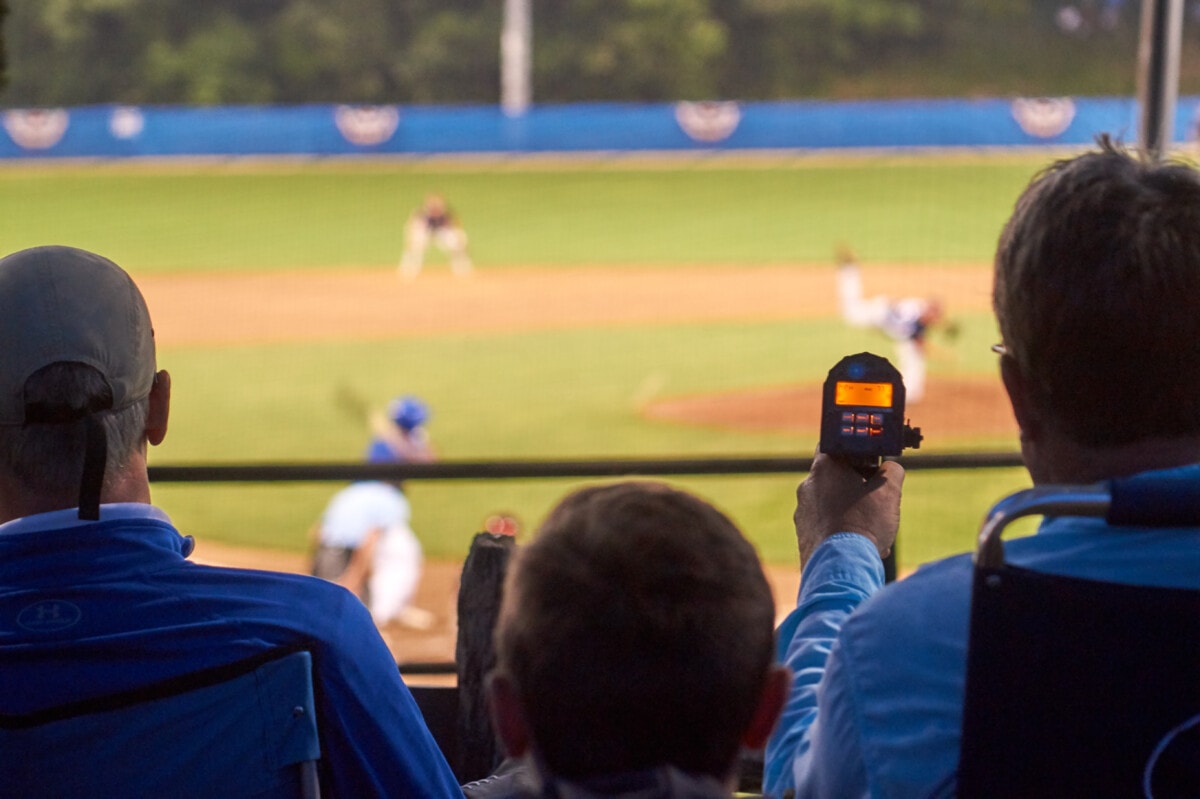Almost all college baseball programs host an annual prospect camp. These events are open to high school-age players and are usually run at the host school’s campus facilities. They offer an opportunity for players to showcase their skills in front of college coaches while also receiving an inside look into the school’s program, facility, and coaching staff.
Typically one-day events, prospect camps will offer players a chance to demonstrate their skills by performing position-specific drills usually followed by live gameplay. Participants will commonly run 60-yard dashes, measure their bat speed and throwing velocity, and field ground balls or fly balls depending on their position.
Not every prospect camp is run in the same format, but this article walks through a common itinerary and what to expect during each stage of the camp.
The Purpose of Prospects Camps
Prospect camps mainly serve three purposes; exposure, insight, and fundraising.
Exposure
Prospect camps give high school players an opportunity to show their skills to a specific college baseball program that they are interested in. For some players, this may be their only chance to get in front of a college coach or scout. It also gives players that are not geographically in the same area as the school an opportunity to showcase themselves to schools that would not typically be scouting in their area. College coaches often use prospect camps and showcases to identify players to follow and further evaluate in their upcoming high school and summer seasons.
Insight
During prospects camps, it is common for participants to receive a tour of the host school’s facility, meet their coaching staff, and learn more about the baseball program. As high school players begin to identify potential colleges they are interested in attending, prospect camps are a great way to get an intimate look into the school and program. Meeting the coaches and hearing about how their program operates gives a player an idea if they see themselves as a potential fit.
Fundraising
For the majority of colleges, baseball is not a revenue producing sport. There aren’t ticket sales or boosters, and the programs rely heavily on fundraising efforts for support. Prospect camps typically cost between $100-$300 for each participant, and the camp proceeds are often directly supporting the program. Players need to keep this in mind when planning out the camps they would like to attend in order to find camps that fit their budget, skill level, and interest.
Itinerary
Most prospect camps last one full day. A typical itinerary consists of an introduction/warmup period in the morning, followed by position-specific evaluations, and will often conclude with live games.
Morning – Check-ins, Introductions, and Warm Ups
Check-in will typically take place at the facility where the camp is happening. Depending on the school and time of year, this may be at an indoor facility or outside at their field. Players will sign in and receive anything the school may be providing, such as t-shirts, ID bib, etc.
After check-in is usually the time the coaching staff will say a few words. They may introduce themselves, talk about their program, and give a tour of the facility. They’ll also provide a more detailed itinerary, and specify where players should be and at what time.
Mid-Day – 60 Yard Dashes, Position Evaluations, and Batting Practice
Following a warm-up, the 60-yard dash is commonly the first event at prospect camps. We discuss the importance of the 60-yard dash in another article, and how it’s a great opportunity to catch the attention of coaches right away.
Following the 60-yard dash, there will usually be a series of position evaluations. Each infielder may get 5-10 ground balls at a time which will serve as their opportunity to display their arm strength, fielding mechanics, and range. Outfield evaluations will usually operate in a similar format, where 5-10 balls are hit to each outfielder and they will field and throw to bases. During this time, coaches may be measuring arm strength with a radar gun. Catchers will also have an opportunity to showcase receiving, blocking, and throwing skills with some drills.
After position evaluations, time permitting, batting practice is usually taken. Each player will receive a round or two of batting practice typically thrown by a coach. This might be done in batting cages or on the field, and it can be expected that exit velocity will be measured during this time. Exit velocity, like the 60-yard dash, can be a quick way to stand out in comparison to the other players. If interested in learning more about exit velocity, we wrote an article to break down exit velocities at every level.
Evening – Live Games
Once the position-specific evaluations are done, participants usually play a live game. Depending on the size of the camp and the number of participants, there may be multiple games taking place simultaneously or one single game. The live games are for coaches to evaluate position players in-game, but more importantly, it is the time for pitchers to throw. Pitchers will be told when to warm up and what inning they will be throwing. This can vary across camps, but it is usually predetermined how much the pitcher will throw, such as 1 inning, 3 batters, 20 pitchers, etc. All pitchers will have an opportunity to pitch and coaches will most likely be behind home plate with a radar gun, recording velocities.
After the games wrap up, this usually concludes the prospect camp. Coaches may have some closing comments, and they might post results of 60-yard dash times, throwing velocities, etc, but other than that, players are usually free to leave.
Preparing for Prospect Camps
Prospect camps can be intimidating and nerve-wracking. Not knowing what to expect combined with the pressure to perform can cause a lot of stress, not to mention the financial commitment. It’s important to prepare as much as possible leading up to the event. Here are a few tips that can help eliminate some of the stress on the day of:
- Read all of the information provided ahead of time; itinerary, locations, parking, what to bring, etc.
- Research the school and coaching staff before the camp.
- Pack extra gear and equipment. It’s better to have it and not need it than to need it and not have it.
- Enjoy the experience… staying relaxed and composed is going to translate to better on-field performance and leave a better impression on the coaches.
- Remember that coaches and scouts evaluate players across all aspects of the game. They look at how players carry themselves, handle failure, consistently perform, and maintain their energy. Don’t let one bad event dictate the rest of the day. Stay confident and play hard.

